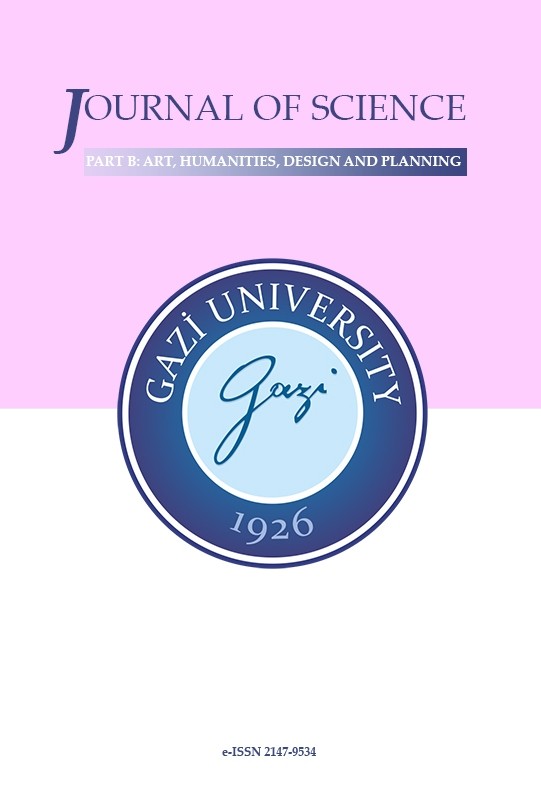Feshane-i Amire Evaluation of Structural System for Adaptive Reuse
Feshane-i Amire, endüstri mirası, yeniden işlevlendirme, yapısal sistem müdahalesi, sürdürülebilirlik
Feshane-i Amire Evaluation of Structural System for Adaptive Reuse
Feshane-i Amire, industrial heritage, adaptive reuse, structural system intervention, sustainability,
___
- [1] Orbaşlı, A., Architectural Conservation, Blackwell Publishing, London, UK, (2008).
- [2] The International Committee for the Conservation (TICCIH), “The Nizhny Tagil Charter for the Industrial Heritage”, (July), 1–6, (2003).
- [3] Elsorady, D., Assessment of the compatibility of new uses for heritage buildings: the example of Alexandria National Museum, Alexandria, Egypt. Journal of Cultural Heritage, 15: 511-521, (2014).
- [4] Douglas, J., Building Adaptation 2. ed., Butterworth-Heinemann, Oxford, UK., (2006).
- [5] Orbaşlı, A., Conservation theory in the twenty-first century: slow evolution or a paradigm shift?, Journal of Architectural Conservation, 23(3):157-170, DOI: 10.1080/13556207.2017.1368187, (2017).
- [6] Li, Y., Zhao, L., Huang, J., and Law, A., Research frameworks, methodologies, and assessment methods concerning the adaptive reuse of architectural heritage: A review, Built Heritage, 5(1):1-19, (2021).
- [7] Karayılanoğlu, G. and Çelik, C., What are the Limits? The Role of Designers on Preserving the Identity in Adaptive Reuse of Urban Industrial Areas, Gazi University Journal of Science Part B: Art Humanities Design and Planning, 9(1):61-73, Retrieved from https://dergipark.org.tr/tr/pub/gujsb/issue/61112/838817, (2021).
- [8] Shen, L. and Langston, C., Adaptive reuse potential: an examination of differences between urban and non-urban projects, Facilities, 28(1):6-16, (2010).
- [9] Bullen, P. and Love, P., Residential regeneration and adaptive reuse: learning from the experiences of Los Angeles, Structural Survey, 27(5):351-360, (2009).
- [10] Department of Environment and Heritage (DEH), “Adaptive reuse: Preserving our past, building our future”, ACT: Department of Environment and Heritage, Commonwealth of Australia (2004).
- [11] Plevoets, B., and Van Cleempoel, K., Adaptive reuse of the built heritage: Concepts and cases of an emerging discipline, Routledge, (2019).
- [12] Cramer, J. and Breitling, S., Architecture in Existing Fabric, Birkhauser, London, UK., (2007).
- [13] Conejos, S., Langston, C., and Smith, J., “Improving the implementation of adaptive reuse strategies for historic buildings”, In Le vie dei mercanti S.A.V.E. HERITAGE, Safeguard of Architectural, Visual, Environmental Heritage, (2011).
- [14] Kincaid, D., Adapting Buildings for Changing Uses: Guidelines for Change of Use Refurbishment, Taylor and Francis, London, UK., (2002).
- [15] Sabnis, G., Rehabilitation, renovation, and Preservation of Concrete and Masonry Structures, American Concrete Institute, Michigan, USA, (1985).
- [16] Rush, R., Same space, different use, American School & University, 77(3):2, (2004).
- [17] Bullen, P. and Love, P., Adaptive reuse of heritage buildings, Structural Survey, 29(5):411-421, (2011).
- [18] Torunbalcı, N., Günay, H. and Köroğlu, N., Adaptive Reuse of Ankara CerModern Art Gallery Evaluation of Structural System, Gazi University Journal of Science Part B: Art Humanities Design and Planning, 10(4): 335-345, Retrieved from https://dergipark.org.tr/tr/pub/gujsb/issue/74633/1176685, (2022).
- [19] ICOMOS, “Principles for the Analysis, Conservation and Structural Restoration of Architectural Heritage”, Victoria Falls, Zimbabwe, ICOMOS, (2003).
- [20] Chudley, R., The Maintenance and Adaptation of Buildings, Longman, New York, (1981).
- [21] Hein, M., and Houck. K., Construction Challenges of Adaptive Reuse of Historical Buildings in Europe, International Journal of Construction Education and Research, 4(2):115-131, (2008).
- [22] Turkish Earthquake Building Code, Republic of Türkiye Ministry of Environment, Urbanization and Climate Change, Ankara, Türkiye, (2018).
- [23] Köroğlu, N., “Analysis of structural system interventions in converted industrial heritage buildings” (Master’s thesis, thesis advisor: Prof. Dr. Necdet Torunbalcı), Istanbul Technical University, Istanbul, Türkiye, (2019).
- [24] Küçükerman, Ö., Feshane Treasurer Factory 1. ed., Sümerbank, Istanbul, Türkiye, (1988).
- [25] Ekiz, M., Eyüp Sultan Feshane Building functional transformation process, Istanbul, (39):135, (2001).
- [26] Boyacıoğlu, D., “Urban and architectural analysis of the Ottoman factory buildings”, (Doctoral dissertation), Istanbul Technical University, Istanbul, Türkiye, (2013). [27] Incirlioğlu, G., Feshane, Arkitekt, 6:66-71, (1991).
- [28] Antay, S., Usta, Tasarım, 30:78-81, (1992).
- [29] Soley, R., Usta, Tasarım, 30:78-81, (1992).
- [30] Halil Onur Architecture, Architectural Drawing and Photo Archive, (2019).
- Yayın Aralığı: Yılda 4 Sayı
- Başlangıç: 2013
- Yayıncı: Gazi Üniversitesi
Restoration Project of Central Cedid Mosque in Erzurum
A Study on The User Satisfaction with The Configuration of Housing Interior Spaces
Neslihan YILDIZ, Anday TÜRKMEN
Embedding Inclusive Design Knowledge into the Learning Process in Architectural Education
Hazal ARTUN, Esra LAKOT ALEMDAĞ
Material Used in 3-Dimensional Printing Technology in the Construction Industry
Feshane-i Amire Evaluation of Structural System for Adaptive Reuse
Hilal GÜNAY, Necdet TORUNBALCI, Naz KÖROĞLU
Historical Evaluation of Public Toilets as Public Spaces
